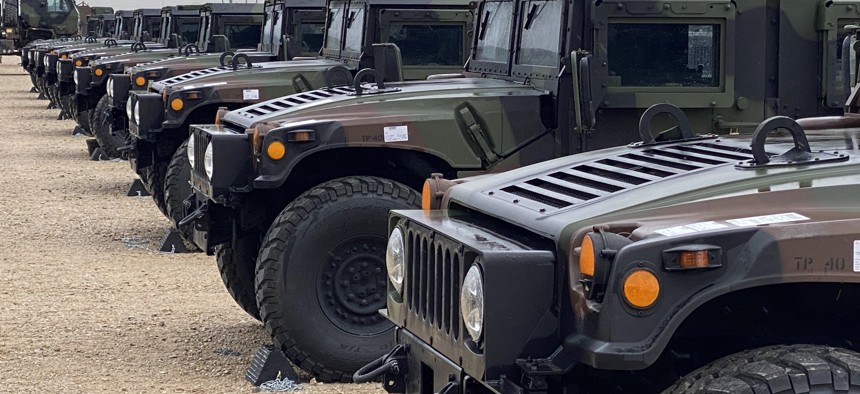
A line of Humvees at the Equipment Configuration Handling Area at Tapa Barracks, Estonia, stand ready for issue to the units participating in DEFENDER-Europe 21. U.S. Army / Cameron Porter
US Military Equipment Ready in Europe For Deploying Forces
The Army’s prepositioned gear allows troops to respond quickly in times of crisis.
American troops heading to Europe due to the Russia-Ukraine crisis will be able to take advantage of the Army’s prepositioned stock of equipment to rapidly deploy to the region, a former commander of U.S. soldiers in Europe said.
Troops dispatched by Wednesday’s deployment order will be taking some equipment from warehouses in Europe, but it’s unclear which units and what type of equipment they will be withdrawing, said Ben Hodges, who led U.S. Army Europe from 2014 to 2017. But, he wrote in an email, “This is why we have [Army Prepositioned Stock] and what I always expected” when he was the commanding general.
The Army’s prepositioned stock for Europe, called APS-2, include vehicles and weapons in Belgium, Netherlands, Germany, and Poland that U.S. troops can use without waiting weeks for their home-based equipment to arrive on ships.
The previous day, Gen. Edward Daly, who leads U.S. Army Materiel Command, was asked about the prepositioned stocks that it manages around the globe.
Daly said the stock includes “combat systems,” like tanks, trucks and weapons.
“They're ready to be issued and they're ready to respond to crisis and conflict,” he said during a Defense Writers Group call with reporters Tuesday.
The Pentagon announced Wednesday that about 1,700 soldiers from an infantry brigade combat team of the 82nd Airborne Division at Fort Bragg, North Carolina would soon be deploying to Poland, as well as 300 soldiers from the 18th Airborne Corps to Germany as part of a headquarters unit.
Additionally, about 1,000 soldiers from a Germany-based Stryker squadron will head to Romania.
These newly announced troops are separate from the 8,500 the Pentagon previously announced were put on ready to deploy orders.
“These movements are unmistakable signals to the world that we stand ready to reassure our NATO allies and to deter and defend against any aggression,” Pentagon Spokesman John Kirby said Wednesday.
Daly said Tuesday the command has not sent additional equipment to preposition for a possible future deployment of additional troops, like the 8,500 on alert. These prepositioned stocks are also separate from weapons and materiel going to Ukraine, he said.
Prepositioning military equipment overseas is not new, going back to the Cold War, said Mark Cancian, a senior advisor of the International Security Program at the Center for Strategic and International Studies.
“So for a long time, the idea has been that you could position the equipment where you think the conflict is going to be, and then you can move the troops in when there's a crisis or an actual conflict,” Cancian said.
The Army has seven prepositioned stock locations, from Europe to the Indo-Pacific in Japan and South Korea, as well as on ships at Diego Garcia, an island in the Indian Ocean. The other military services also have prepositioned stocks located around the world.
The Army’s stocks have gone through an overhaul in the past few years due to a new strategy. About a decade ago, the equipment was dated and was more for use in an emergency, Daly said. Now, these stocks have the most up-to-date equipment and supplies and are used regularly through exercises, such as the recent DEFENDER-Europe 21.
“We want to use it during exercises because that creates a muscle memory and now it allows speed of issue if we would have to do it under duress or under contested conditions,” he said.
For 2022, the Defense Department requested $1.19 billion for prepositioned stocks as part of the European Deterrence Initiative, less than the $1.94 billion it had received the year before, according to a Congressional Research Service report.
If troops need to move the equipment from one country to another, that is where things can get bogged down in bureaucracy with regulations and requirements that were designed for commercial activities having to be applied to a military convoy, Cancian said.
“Apparently that's been a huge problem, because at least the peacetime regulations are quite onerous about crossing borders and the other requirements for shipping ammunition or tanks, you know, big things like that. They've had delays of many weeks in connection with trying to move equipment,” he said.





